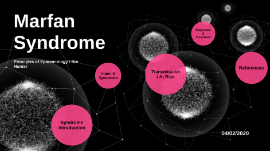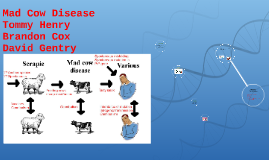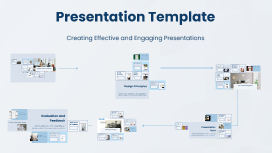Marfan Syndrome - Disease Presentation
Transcript: Marfan Syndrome Principles of Epidemiology / Bre Hunter 04/02/2020 Introduction Syndrome Introduction Marfan Syndrome is a genetic disorder that affects the body's connective tissue (CT) and causes excessive growth. (Marfan Foundation, 2014) Connective tissue (CT) is what holds cells, organs, and other body tissues together, making it important for proper growth and development (Marfan Foundation, 2014) Found throughout the body, this disorder can cause abnormalities in many parts including the heart, blood vessels, bones, joints, eyes, lungs, skin, and nervous system (Marfan Foundation, 2014) FBN1 Gene Causes Marfan syndrome is caused by a mutation in the FBN1 gene (National Library of Medicine, 2020) This gene provides instructions for making the protein fibrillin-1, which bind to form microfibrils that provide strength and flexibility to connective tissues (NLM, 2020) They also release and control growth and repair hormones for tissues and organs in the body (NLM, 2020) The mutation reduces the amount of fibrillin-1, which decreases microfibril formation (NLM, 2020) The lack of microfibrils leaves excess growth factors and decreased elasticity, which leads to overgrowth and instability of tissues (NLM, 2020 Inheritance Pattern Inheritance As stated, Marfan Sydrome is genetic. It is inherited in an autsomal dominant pattern, where one copy of the altered gene in each cell is enough to cause the disorder (National Library of Medicine, 2020) At least 25% of the cases result from a new mutation in the FBN1 gene (NLM, 2020) These cases occur in people with no family history of the disorder (NLM, 2020) Signs & Symptoms Signs & Symptoms Signs of Marfan Syndrome can appear at any age, starting as early as birth or later in life (Marfan Foundation, 2014) Some signs are progressive and can get worse over time/or without treatment (Marfan Foundation, 2014) Every person's experience can vary, some showing more features and some with different combinations of features (Marfan Foundation, 2014) These different factors make it important for ongoing monitoring (Marfan Foundation, 2014) Marfan Syndrome does not affect intelligence (Marfan Foundation, 2014) Easy-to-see Signs Easy Signs Long arms, legs and fingers Tall and thin body type Curved spin Chest sinks or sticks out Flexible joints Flat feet Crowded teeth Stretch marks unrelated to weight gain or loss (Marfan Foundation, 2014) *These features can be categorized as mild or severe, and may show up in different combinations (Marfan Foundation, 2014) Hard-to-see Signs Harder Signs Heart problems Aortic enlargement can cause aneurysm, tears in the layers of aorta (dissection), and "floppy" mitral valve Sudden lung collapse Eye problems severe nearsightedness, dislocated lens, detached retina, early glaucoma, and early cataracts (Marfan Foundation, 2014) *These features often need special tests to be detected.(Marfan Foundation, 2014) What it Looks Like Some examples of what Marfan Syndrome may look like in some individuals are provided here: What Marfan Syndrome Looks Like Transmission / At Risk Transmission / At Risk As stated earlier, this a genetic disorder so it cannot be transmitted any other way than through genetics (NLM, 2020) Marfan Syndrome affects men and women equally among all races and ethnic groups (Mayo Clinic, 2019). The greatest risk factor is having a parent with the disorder (Mayo Clinic, 2019). Risks within the Disorder Risks and Complications Heart Conditions Eye Conditions Skeletal Conditions Lens dislocation can occur, where the focusing can move out of place (if support is weakened) This disorder increases the risk of detachment or tear in retina, which lines the back of the eye Early on-set glaucoma, which is increased eye pressure that can damage the optic nerve, and cataracts that cause cloudy areas (Mayo Clinic, 2019). Marfan syndrome increases the risk for abnormal curves in the spine, such as scoliosis It can also cause the breast bone to protrude or sink in, raising the risk for collapsed lungs Foot and lower back pain are also common (Mayo Clinic, 2019). The most dangerous complication and risk within this disorder involves the heart and blood vessels. Faulty connective tissue can weaken the aorta and cause rupture This condition can also be categorized as heart disease (Mayo Clinic, 2019). Disorder Incidence Incidence Marfan Syndrome is a rare disorder It happens in about 1 in 5,000 people worldwide One in four people with the disorder develops the condition for unknown reasons A person with Marfan Syndrome has a 1 in 2 chance of passing it on to their child (CDC, 2019) Statistics Statistics According to one study in 1999, 130 patients with Marfan Syndrome were evaluated. It was found that 5 and 10 year survival rate after diagnosis was 95% and 88%. The complication free survival rate was 78% and 66% Thirteen patients developed dissection, 30 underwent prophylactic repair, and 82 had an uncomplicated course (Groenink et al., 1999)

















